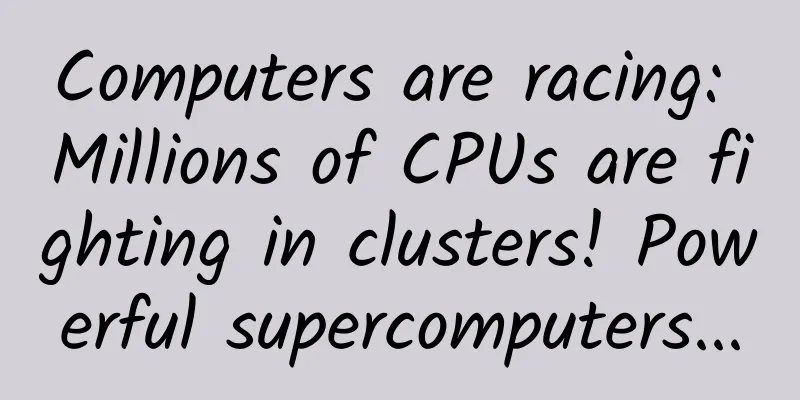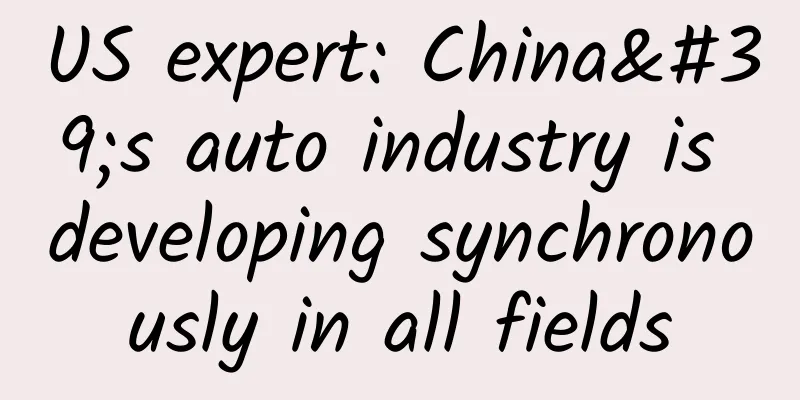Computers are racing: Millions of CPUs are fighting in clusters! Powerful supercomputers...

|
Produced by: Science Popularization China Author: Luan Chunyang (Department of Physics, Tsinghua University) Producer: China Science Expo Whenever a new smartphone or home computer is released, the most discussed topic is always the computing performance and heat dissipation of the central processing unit (CPU). We may not know the specific computing architecture inside the CPU of electronic devices, but we can truly feel the huge changes that the improvement of CPU computing power has brought to our lives and work. In fact, from the scientific calculators we often used in middle school to the laptops we need for daily office work, all these electronic devices with data processing capabilities can be collectively called electronic computers. So, based on the classical computer, are there faster and more powerful computers? (Photo source: Veer Gallery) The wonderful world of "0" and "1" Every time we press a button on a mobile phone or a computer keyboard, these characters or information first need to be converted into codes that can be processed by electronic computers: combinations of 0s or 1s. For example, according to the character encoding of ASCII (American Standard Code for Information Interchange), the English letter K is encoded as "01001011". After being processed by the computer CPU, a string of 0 or 1 encoded information can be converted into letters or pictures that we recognize and appear in front of us. In the CPU of an electronic computer, an electronic transistor can be used as the basic unit for numerical calculations of 0 or 1. At this time, the passage of the electronic transistor can represent the value 1, and the open circuit represents the value 0. When millions of electronic transistors and other electronic components are packaged on a small semiconductor chip through the ultra-large-scale integrated circuit process, this integrated circuit with data processing capabilities and micro-packaging is generally referred to as a "chip". (Photo source: Veer Gallery) 16 cores not enough? Then add a few more billion! However, with the increasing number of data processing tasks in life and work, the computing power of a single CPU core on electronic devices is often difficult to meet the demand. At this time, we can integrate multiple computing cores on the CPU to ensure that multiple cores can process data tasks independently at the same time. Common commercial computers now generally use 8-core CPUs, and even some workstations used to handle large computing tasks have 16-core CPUs. But even such high-performance computers can hardly meet the increasingly complex computing needs. Taking our common weather forecast as an example, the computer needs to discretize the atmosphere of a specific area into grids for numerical simulation. If the weather forecast for the next three days is to be accurate to more than 90%, it will require up to tens of billions of floating-point operations. If an ordinary commercial computer is used for calculation, it will take at least half a month. In addition, urban intelligent transportation and online cloud computing supported by big data centers require exponential data processing capabilities. Therefore, people began to interconnect up to millions of CPUs to work together to build a "supercomputer" capable of parallel computing. (Photo source: Veer Gallery) In fact, "supercomputer" is not a single computer with super computing power, but the abbreviation of supercomputer cluster. In other words, each node in a supercomputer cluster is an independent computer. Its "super" lies in the unique node interconnection structure inside it, so that thousands of CPUs on all nodes can be scheduled at the same time, and each CPU generally has dozens of physical cores, thus having exponential data processing capabilities. However, the "supercomputer" is not an all-round player. It only has powerful processing capabilities for algorithmic problems that can be calculated in parallel, but cannot speed up the processing of data tasks for serial calculations. In addition, the task scheduling strategy of the "supercomputer" operating system and the optimization of the compiler also greatly affect its own performance. The serial/parallel computing tasks here can be understood in a simple way: a pile of earth that originally requires one person to move in 10 hours can also be moved by 10 people in 1 hour. However, if it takes one person 10 hours to dig a well that can only accommodate one person, it is impossible to arrange 10 people to complete it in 1 hour. This is a serial computing task that even a "supercomputer" cannot efficiently handle. Therefore, a "supercomputer" is not simply a stack of CPUs and computing cores. Its accelerated computing capability not only relies on the highly coordinated interconnection between CPU cores, but also on optimizing the algorithmic order of data processing tasks to fully utilize the computing potential of each CPU. (Photo source: Veer Gallery) The well-known "Sunway TaihuLight" supercomputer has a total of 40,960 CPUs, and its peak computing speed has reached 12.54 quadrillion times/second, and its sustained computing speed has reached 9.3 quadrillion times/second. The "Sunway TaihuLight" supercomputer helped the teams of Tsinghua University, Beijing Normal University and the Chinese Academy of Sciences complete the "Global Atmospheric Non-hydrostatic Cloud Resolution Simulation" and achieved a global 10-kilometer high-resolution numerical simulation of the Earth system. This research achievement further enhanced my country's ability to monitor natural disasters under complex meteorological conditions. At present, "supercomputers" are widely used in molecular dynamics simulations in medical research and development, fuel cell design in electric vehicles, aerodynamic shape optimization in aircraft design, boundary stability calculations of confinement devices in the field of nuclear fusion, and quantum mechanics technology in atomic physics. (Photo source: Veer Gallery) Supercomputers have limitations However, the construction of a "supercomputer" not only requires an investment cost of billions of yuan, but also requires daily electricity expenses of up to hundreds of thousands of yuan. In addition, the huge volume of thousands of cubic meters and the complex water cooling system also limit the further development of "supercomputers". Therefore, people began to rethink how to make computers achieve stronger data computing capabilities with smaller size and lower power consumption. (Photo source: Veer Gallery) A natural idea is to integrate more transistors on the same chip. Gordon Moore, one of the founders of Intel, proposed "Moore's Law", which states that the number of transistors on an integrated circuit will double every 18 to 24 months, and the data processing capacity of the CPU will double. This is why even the CPU of our current mobile phones priced at 1,000 yuan has stronger computing power than commercial computers ten years ago - because the density of transistors has increased. However, "Moore's Law" cannot be maintained forever. One of the reasons is that the photolithography process used for chip microcircuit processing has approached the optical diffraction limit of 2~3nm, and it is difficult to further increase the density of transistors while ensuring the chip yield. In addition, as the size of transistors continues to decrease, leakage between electrodes and huge heat dissipation problems will also cause chip performance failure. Faced with such a dilemma, does it mean that our computer technology has reached a bottleneck? Don't worry, the author will naturally reveal the answer to you in the next article. Editor: Sun Chenyu |
<<: The Woodpecker, the “Forest Doctor”? Is the Woodpecker a “Good Doctor”?
>>: Money Back! Starting Today!
Recommend
Apple, which is "never satisfied", continues to attack from all sides
[[136329]] Although the outside world had basical...
Hua Chunying responded to the Harvard University COVID-19 paper full of loopholes. Let’s take a look at the details!
The American Broadcasting Corporation reported th...
How to build an Internet finance product community?
Forums, as one of the first gathering places for ...
Long March 5B rocket: The unique skills of the "big guy"
At 14:22 on July 24, the Long March 5B carrier ro...
Don’t thaw meat in water anymore! New way to thaw meat——
Review expert: Wang Xiaohui, deputy senior engine...
Marketing Campaign Process Guide
As for the development process of building market...
Hema Fresh Product Analysis
Hema Fresh is an important part of Alibaba's ...
Tencent News advertising display style and material specifications!
Tencent News Advertisement is an industry-leading...
Turtle Class Tik Tok Becomes Real Combat Training Camp 2
With the arrival of March, our Turtle Class Tik T...
I heard that people in Guangdong are buying long johns overnight because they are almost crying from the cold!
Key Points ★ The perceived temperature is actuall...
Airbnb’s Growth Case Study
Airbnb, Chinese name:爱Airbnb , is a service websi...
Why is dog poop often mixed in with archaeological sites?
If you have the opportunity to become a student m...
360 brings in the Coolpad master: How much of a role can he play?
Qihoo 360 invested 400 million US dollars to form...
Phytochemicals as “defenders” in the food immunity “battle”
Food is the best source of immune barrier for the...
Young people's first car should be sporty, fashionable and economical. Emgrand GS can satisfy you.
Nowadays, more and more young people have entered...









